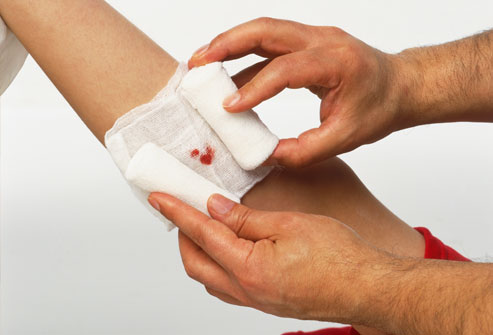How to help a victim with a laceration
Contents of the article: classList.toggle()">toggle
Violation of the integrity of the skin and mucous membranes, which is formed under the action of a rupture when the skin’s ability to tension stops - this is called a laceration.
Such a lesion occurs with damage to muscles, blood vessels, nerve fibers and is accompanied. The boundaries of the wound are uneven, sometimes significant skin detachment and scalping are noticeable. In this case, only surgical treatment is used, but in any situation it is clearly necessary to provide first aid as soon as possible.
What is a laceration
Violation of the integrity of the skin occurs at an acute angle; as a result of a blow with a heavy object, areas of exfoliated skin are formed. This type of damage is characterized by shallow depth and ragged edges. The resulting wound does not gape, but the detached skin flap often has a large area and can be completely torn off.
Causes of lacerations:
Blood flows from such an injury to a lesser extent than, for example, from cut wounds, but they are more contaminated, since a fall often occurs on gravel or asphalt.
If hair gets caught in moving mechanisms as a result of a laceration, scalping of the scalp occurs with partial or complete tearing of the skin.
Scalping of arms or legs occurs during an accident if a limb falls under the wheels of a vehicle.
Most often, such injuries occur among motorcyclists, cyclists, summer residents, fishermen or hunters.
Symptoms
The degree of damage caused directly affects how severe the symptoms are. Very often, the damaged area becomes infected, as dirt, fabric from clothing, glass fragments, small pebbles, and sand get into the wound.
Immediately after receiving a laceration, a person feels a sharp pain. In some cases, the scalped piece hangs from the surface, and complete or partial detachment of individual lesions occurs.
Symptoms of a laceration injury:
- The boundaries of the lesion are irregular, patchy, crushed;
- At the bottom of the wound, a fatty layer is noticeable, a little less often muscle fibers or tendons;
- Subcutaneous hematomas are formed;
- Sensitivity is lost around the damaged area.
In rare cases, these wounds are combined with other types of injuries, such as fractures of the arms, legs, spine, traumatic brain injuries, pelvic fractures, and rupture of internal organs.
First aid for lacerations
To help a victim with lacerations, you need to follow a few basic steps, just like with other injuries.
Stop bleeding
The victim needs to wait until the emergency medical team arrives. To do this, it is necessary to determine the amount of blood loss and the type of bleeding.
If the blood does not flow out of the wound much, it is enough to press the vessel with your fingers.
In case of massive bleeding and in cases where the exact location of the laceration cannot be determined, it is necessary to apply a tourniquet or a tight pressure bandage.
If there is no medical tourniquet nearby, you need to stop the nearest car and use a car first aid kit. You can also use thick fabric, a scarf, a belt, or a scarf for twisting.
Keep the tourniquet on the damaged area for no more than 2 hours in the summer, and no more than 1.5 hours in the winter.
Similar articles 
Treatment of a laceration
While at home, as part of the treatment of a laceration, it is necessary to exclude further infection - the damaged area should be treated with any antiseptic. It is best to use 3% hydrogen peroxide for this; it creates abundant foam on the surface, which helps remove dirty elements.
After treatment with peroxide, the wound must be dried with a sterile gauze swab and the edges of the injury must be treated, including healthy areas of skin.
You can treat the edges of the injury using any alcohol solution: brilliant green, iodine solution, alcohol or vodka.
Dressing
The next step is to bandage the damaged area to maintain sterility after treatment.
Small damage is isolated using a sterile napkin and adhesive tape. Major injuries should be bandaged with sterile material or a clean cloth.
Treatment of lacerations
An injured person should be quickly taken to a hospital, where he will receive qualified care.
First aid for a laceration in an outpatient setting:
- Small injuries are treated on an outpatient basis;
- The surface is washed abundantly with antiseptics, non-viable edges swell, drain or suture;
- If the outcome is successful, the suture material is removed on the 10th day;
- If the wound is infected, it is washed, if necessary, opened and expanded, freed from purulent contents, non-viable tissue is removed, and drainage is applied without sutures.
Victims who have extensive lacerations are subject to hospitalization in traumatology. Most likely, such patients experience traumatic shock and require urgent anti-shock measures. The earlier the measures are taken, the more favorable the prognosis.
In the intensive care unit, the condition of the victim, the nature of the injury, and the severity of the injury are taken into account. The patient is given active pain relief, all measures are used to restore blood circulation, cardiac activity, and breathing.
Qualified doctors for serious laceration injuries:

During the healing and epithelialization phase, patients are given restorative treatment, dressings are carefully made using antibacterial drugs, which further increase tissue regeneration.
If the injured area is very extensive and a large skin defect is observed, free skin grafting or grafting with a displaced flap is performed.
Drugs and antibiotics for lacerations
You can exclude the possibility of the wound going into a purulent stage and prevent various complications with the help of antibiotics.
In order to prevent complications of injury, specialists may prescribe the following groups of antibiotics for lacerations:
- Penicillin antibiotics - Amoxicillin, Ampicillin, Benzylpenicillin, Ampiox, Oxacillin;
- If the pathogen is resistant to penicillin, cephalosporins are prescribed - Cephamizin, Cephalexin, Cefazolin;
- Macrolides are used if the pathogen is resistant to both penicillin and cephalosporins. These are drugs such as Erythromycin, Macropen, Spiramycin, Roxithromycin;
- In some cases, a tetracycline series of drugs is prescribed - Minocycline, Tetracycline.
Most often, in the absence of allergic reactions, antibiotics from the penicillin series are prescribed; their use causes the least harm to the body.
Consequences of injuries and healing time
After healing, lacerations leave large blemishes on the skin. To prevent this, skin grafting is done immediately after first aid and cleansing the wound.
Skin grafting methods:
- The operation is performed on large wounds with a clean bottom and beginning healing. The graft is taken from the front of the thigh or from the abdominal area. The flap is applied to the wound, straightened on the surface, and sewn along the border. A pressure bandage is then applied to compress the flap. Healing takes place within 2 weeks;
- The method of displaced skin flap is used for granulating lacerations after infection is eliminated, the wound bed is cleared of necrosis, and microcirculation and blood flow are restored.
The essence of the displaced skin flap method is that the skin defect is replaced with a piece of skin from neighboring areas.
Before the operation, the surgeon draws up a movement plan, depending on the shape of the damaged surface. Most often, counter pieces are used in the form of rhombuses or triangles. The graft takes root within 10 days.
It might be useful to read:
- Beaver catching at different times of the year;
- Emergency aid for drowning;
- How to behave in a thunderstorm. Safety regulations;
- How to make a fish dryer with your own hands;
- Medical glue "bf";
- The first sensible review of dry rations from a woman;
- The best steel for a hunting knife;
- Do-it-yourself sundial: decorate the dacha and kindergarten playground;